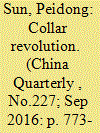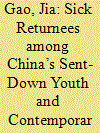| Srl | Item |
| 1 |
ID:
148772


|
|
|
|
|
| Summary/Abstract |
Scholars have paid little attention to Maoist forces and legacies, and especially to the influences of Maoism on people's everyday dress habits during the Cultural Revolution. This article proposes that people's everyday clothing during that time – a period that has often been regarded as the climax of homogenization and asceticism – became a means of resistance and expression. This article shows how during the Cultural Revolution people dressed to express resistance, whether intentionally or unintentionally, and to reflect their motivations, social class, gender and region. Drawing on oral histories collected from 65 people who experienced the Cultural Revolution and a large number of photographs taken during that period, the author aims to trace the historical source of fashion from the end of the 1970s to the 1980s in Guangdong province. In so doing, the author responds to theories of socialist state discipline, everyday cultural resistance, individualism and the nature of resistance under Mao's regime.
|
|
|
|
|
|
|
|
|
|
|
|
|
|
|
|
| 2 |
ID:
180007


|
|
|
|
|
| Summary/Abstract |
China’s first cohort of the sent-down youth during the Cultural Revolution has since its early years attracted considerable research interest and been analysed from a few different viewpoints. However, the gradual retreat from executing the sent-down policy, especially bingtui (return to urban centres of origin because of medical reasons) as the then widely used tactic, and its long-term impact on people’s socio-political attitudes and behaviours have not been examined and evaluated adequately. This has resulted in a large discrepancy between the non-academic discourse of returning sent-down youth, including bingtui, and the academic literature on these aspects in both Chinese and English. As revealed by many non-academic publications, bingtui not only represented the emergence of a widespread popular resistance to the Maoist Cultural Revolution that involved mobilising those who were then sent to the countryside, but was also believed to be responsible for a surge in what has since become known as songli feng (a wave of gift-giving practice). Based on the information recorded in published personal memories of many sent-down youth and other published accounts, online and print, as well as the information collected from my own past observations and recent interviews, this article will go beyond both glowing and condemnatory documentations of the sent-down movement of the late 1960s and 1970s and seek to analyse how bingtui was started, how it was utilised by sent-down youth and their families and, importantly, how it had led more Chinese people to realise that certain aspects of their identity could be performed.
|
|
|
|
|
|
|
|
|
|
|
|
|
|
|
|